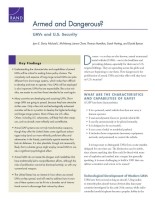| 来源类型 | Research Reports
|
| 规范类型 | 报告
|
| ISBN | 9780833085887
|
| 来源ID | RR-449-RC
|
| Armed and Dangerous? UAVs and U.S. Security |
| Lynn E. Davis; Michael J. McNerney; James S. Chow; Thomas Hamilton; Sarah Harting; Daniel Byman
|
| 发表日期 | 2014
|
| 出版年 | 2014
|
| 页码 | 32
|
| 语种 | 英语
|
| 结论 |
Longer-Range Armed Drones Are Unlikely to Spread Broadly - The complexity and expense of long-range armed unmanned aerial vehicles (UAVs) are quite different from short-range systems, which make them difficult to develop and even to operate.
- Many countries are developing and acquiring drones. Short-range drones are going to spread, because they have attractive civilian uses. Only a few rich and technologically advanced countries will be in a position to develop the higher-technology and longer-range armed systems.
Armed UAVs Are Not Truly Transformative- Armed UAV systems are not transformative weapons, though they offer the United States some significant advantages, particularly against enemies that lack air defenses. It is plausible, though not necessarily likely, that a substate group might employ armed drones to create a significant psychological effect. Innovations, such as the discovery of ways to make stealth technology cheap and easily available, could alter these conclusions, but none of these are likely.
- Armed UAV systems do not create the global dangers and instabilities that have traditionally led to nonproliferation efforts, although the risks of proliferation cannot be dismissed entirely, as is the case with any conventional weapon.
- Armed drones are only transformative in rare circumstances but they offer policymakers another option for intervention, in some cases where they would otherwise do nothing, while in other situations in lieu of a more costly and aggressive approach.
- U.S. policymakers will be able to craft policies for armed drones that address the potential risks of proliferation while being able to continue its own acquisition and potential sales to allies and partners. The MTCR and Wassenaar Arrangement will be useful in achieving these twin goals.
Shaping International Behavior- The United States will need to address how its own use of these systems can be fit into a broader set of international norms so as to discourage their misuse by others. While the track record for constraining the use of emerging technologies has been mixed, there is evidence that U.S. leadership — and failure to lead — can matter in shaping international behavior.
|
| 摘要 |
- Ultimately, changes to U.S. armed UAV policies and efforts to shape international norms should be based on evaluating and balancing competing risks.
- Decisionmakers must consider the risks to U.S. counterterrorism and other missions that might come from more transparent and restrictive armed UAV policies. On the other hand, there may be longer-term risks that — without U.S. policy changes and without international norms — other governments and substate groups may acquire and use armed UAVs in ways that threaten regional stability, laws of war, and the role of domestic rule of law in decisions to use force.
- Those concerned about these longer-term risks — particularly from operations outside warzones — should focus on shaping international norms; providing leadership through example and through forums; and developing a set of guidelines.
|
| 主题 | Arms Proliferation and Control
; Global Security
; Military Technology
; Threat Assessment
; United States
|
| URL | https://www.rand.org/pubs/research_reports/RR449.html
|
| 来源智库 | RAND Corporation (United States)
|
| 资源类型 | 智库出版物
|
| 条目标识符 | http://119.78.100.153/handle/2XGU8XDN/107846
|
推荐引用方式
GB/T 7714 |
Lynn E. Davis,Michael J. McNerney,James S. Chow,et al. Armed and Dangerous? UAVs and U.S. Security. 2014.
|
|
文件名:
|
x1495316373355.jpg
|
|
格式:
|
JPEG
|

|
文件名:
|
RAND_RR449.pdf
|
|
格式:
|
Adobe PDF
|
除非特别说明,本系统中所有内容都受版权保护,并保留所有权利。